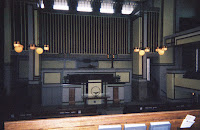It’s one of the astonishing facts of American creativity that in the first decade of the 20th century, Oak Park, Ill.—a community of only 10,000 at the time—would house two geniuses who, by making a virtue of simplicity, transformed the world’s culture. One was Nobel Literature laureate Ernest Hemingway, then only a child. The other was the adult architect Frank Lloyd Wright.
Visitors to the town can still see a number of homes
that Wright designed when he started his practice. But a structure of a
different kind is Unity Temple, which I visited—and photographed—while vacationing
in the Chicago area in October 2004.
This building was brought to my attention by Jim Stewart’s
“10 Sacred Sites in America Worth Seeing” post on “The Discoverer” blog.
I have my issues with his list (not a single Catholic church on it?), and he
lists Unity as being in Chicago rather than Oak Park, a suburb of the city. But
he did remind me of what a worthwhile building this is.
Readers of this blog know that I frequently include
pictures of religious institutions. Many, I found in researching their history,
were created by architects who specialized in such structures. But, out of the
approximately 1,000 buildings designed by Wright in his nearly 70-year career,
only 10 fit this description.
Wright, a member of this Unitarian congregation, offered
to design this church after its predecessor burned to the ground following a
lightning strike. Wright being Wright, his building costs doubled the original
projection of $45,000. But Wright being Wright, he also revolutionized how people
would experience such spaces.
What Wright had in mind to replace the traditional Gothic revival church building that had stood here was a structure with no steeple or front entrance, to be built entirely of poured-in-place, exposed concrete—a forerunner of 20th-century design.
Minus traditional
religious iconography, the sanctuary emphasizes light and space. It gives rise
to introspection and meditation, in keeping with the commission’s request for a
building that would embody the principles of “unity, truth, beauty, simplicity,
freedom and reason.”
When I visited, I understood perfectly how Paul
Hendrickson, in his 2019 biography of the architect, Plagued by Fire,
felt sitting in a pew in the church, “with all its light and silence and seeming
saving grace pouring down.”
When the temple was formally dedicated in 1909, Wright
was not on hand for the ceremony, having departed Oak Park in scandal because
of an affair with the wife of a client. But, if so much of his life was profane
with its ego, arrogance and deceptions, Unity Temple represented his belief in
the sacred.

No comments:
Post a Comment